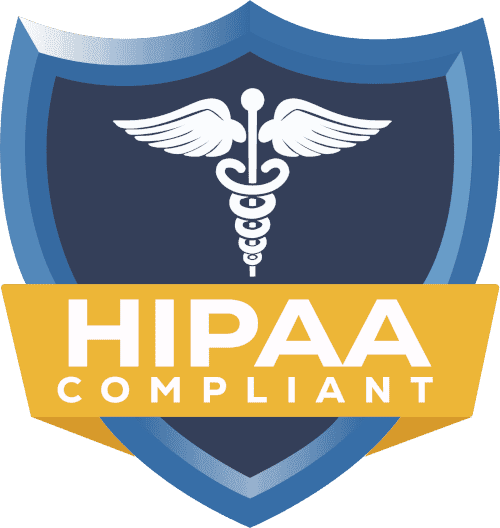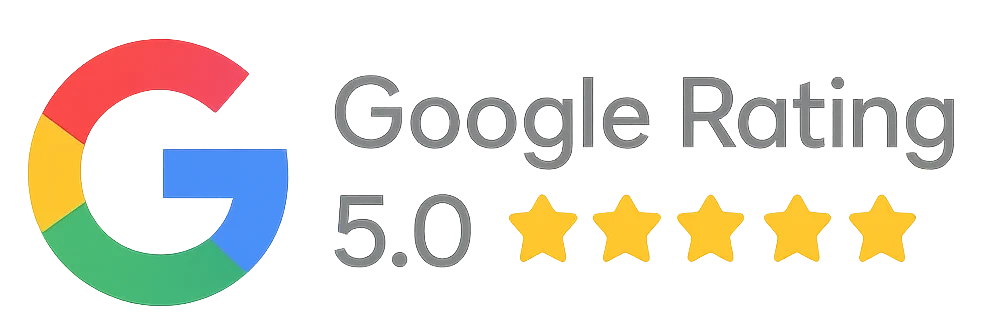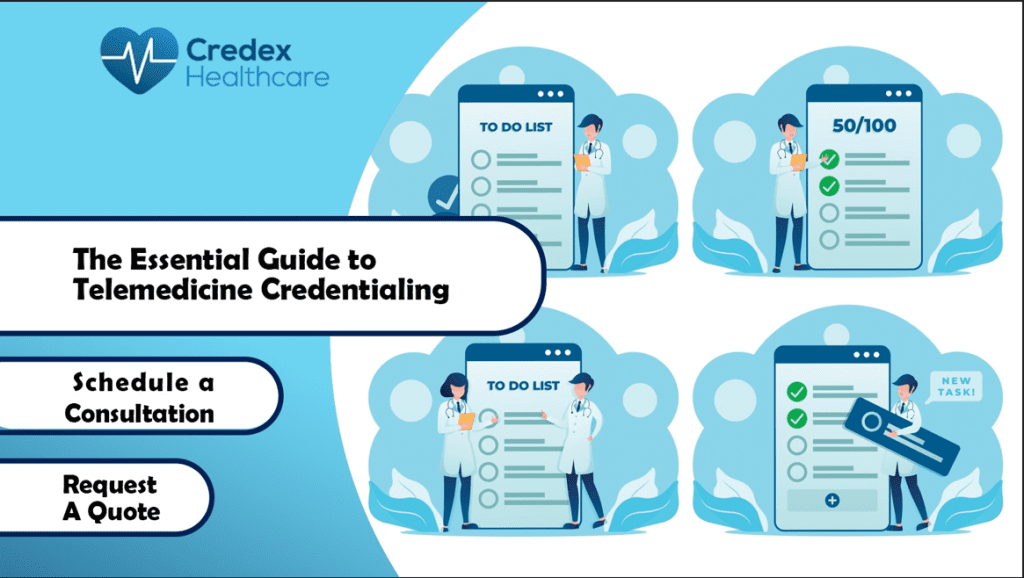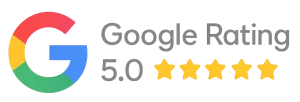GET YOUR FREE CHECKLIST FOR YOUR NEW OR EXISTING PRACTICE!
Launching or growing a medical practice? Whether you’re starting from scratch or expanding an existing provider network, the process can feel overwhelming, but you don’t have to do it alone.
At Credex Healthcare, we’ve supported hundreds of healthcare providers in building successful, compliant, and efficient practices. To help you get started on the right path, we’re offering a FREE, expert-crafted Provider Credentialing Checklist — designed specifically for medical practices and providers like you.
🔹 New to private practice?
🔹 Hiring or credentialing new providers?
🔹 Looking to streamline your operations?
This checklist is your step-by-step guide to covering all the essentials from credentialing and payer enrollment to compliance and workflow readiness.
There’s no catch and no obligation, just actionable insights from a trusted partner in healthcare support.
Fill out the quick form, and we’ll send your Free Ultimate Credentialing Checklist right to your inbox.
Credex Healthcare – powering your practice with confidence.
Request Checklist
WHAT’S INCLUDED IN OUR CREDENTIALING CHECKLIST
Credentialing can be complex, but it doesn’t have to be. Our all-in-one checklist is designed to simplify the process for both new and existing practices. Whether you’re onboarding a single provider or managing a multi-provider group, this tool ensures you stay compliant, organized, and ready for payer enrollment.
Here’s what you’ll get:
- Group & Facility Credentialing Sections
Includes dedicated sheets for group/facility setup, ownership structure, and key operational data essential for enrolling new or expanding practices with payers. - Centralized Login & Access Information Tracker
Keep all system and payer logins, TINs, NPIs, CAQH details, and PECOS information in one secure and editable sheet, making updates and audits faster and easier. - Built-in Status & Remarks Columns
Track which items are completed, pending, or missing. Each row includes a status field so you never lose sight of what’s needed. - Provider Questionnaire Template Included
A structured, easy-to-use form to collect key details directly from providers, speeding up internal coordination and data accuracy. - Designed for ALL Specialties & Practice Types
Whether you’re a solo provider, part of a group, or managing multiple locations, this checklist adapts to your structure and workflows. - Fully Editable & Customizable Excel Format
Download and tailor the checklist to your organization’s internal processes. Use it as a live tracker, onboarding tool, or audit preparation document.
Why Clients Trust Us
Years
12 Years of Provider / Hospital Credentialing and Enrollment experience
States
Extensive experience in all 50 states / State regulations / Rules and Compliance
Applications
Over 120,000+ applications successfully filed and contracts received
1. Established Group - New Provider Credentialing Checklist
Scenario 1: You’re joining an existing group? Here’s what you need to get your credentialing ducks in a row.
- Updated and attested CAQH profile – This is your credentialing passport, so make sure it’s current. You’ll need to add your new practice affiliation with your start date. Oh, and if you’re moving states? Don’t forget to update your license and DEA to match where you’ll actually be practicing. Trust me, this oversight causes more headaches than you’d think.
- Payer list from your new group – Ask the group to provide their complete contracted payer roster. We’re talking commercial plans, Medicare Advantage, Medicaid HMOs, workers’ comp, Tricare, and any third-party administrators they work with. This isn’t just helpful; it’s essential for knowing where you can actually get paid.
- Tax documentation – You’ll need the group’s W9 with their pay-to address plus their CP 575 or 147C letter. These documents get uploaded to CAQH and submitted to insurance companies. Think of them as your financial DNA for credentialing purposes.
- Hospital privileges sorted out – Some specialties and payers require hospital credentialing. You’ll need to identify which hospitals you plan to have privileges with in CAQH. No hospital privileges? No problem. Set up an admitting arrangement with another provider nearby, or figure out which hospitalist group or emergency department you’ll partner with for admissions.
- Malpractice coverage updated – Either get a new policy or update your current one to include your new employment. This goes straight to CAQH. Here’s the catch: you need to be listed as the named insured on the certificate, not just covered under the group’s blanket policy.
- Group’s Type II NPI – You’ll need the group’s primary billing NPI number for applications, along with their tax ID. These two pieces of info are like peanut butter and jelly for credentialing applications.
- Medicare PTAN linkage – Get the group’s Medicare PTAN number so you can link in your Medicare application. This connects you to their existing Medicare enrollment.
Required Documentation for Adding New Provider to Existing Practice:
- Professional state license
- DEA certificate (if applicable) or covering provider name. Quick heads up: If your DEA is from a different state than where you’re applying, you’ll need to transfer it first
- CDS certificate (if applicable)
- Board certification or proof of board eligibility
- Professional liability insurance certificate (must have expiration date more than 60 days in the future throughout the entire credentialing process)
- Professional school diploma
- Certificates of completion for internships, residencies, and fellowships
- CAQH login credentials (if you don’t have CAQH yet, we’ll need: name, date of birth, SSN, home address, and city/state of birth)
- PECOS login and password
- State Medicaid system credentials (if applicable)
- Availity system login, password, and backup codes
- Current CV with ALL begin/end dates for education and training listed as EXACT dates (day/month/year), not just month/year. Yes, this level of detail matters.
- Hospital admitting privileges or covering provider info. If you have your own privileges, include hospital name, staff status/category (active staff, consulting staff, courtesy staff, etc.), and appointment date.
2. New Practice - Provider Credentialing Checklist
Scenario 2: Starting fresh with your own practice? Here’s your roadmap from zero to credentialed.
- Establish your group legally – First things first: register your new group in your state. You’ll need to get your tax ID through the IRS, which you can handle online at: https://www.irs.gov/businesses/small-businesses-self-employed/apply-for-an-employer-identification-number-ein-online
- Download your CP-575 – When you get your EIN, make sure to download the electronic file called CP-575. You’ll need this document repeatedly throughout the credentialing process.
- Secure your service address – I know it feels early, but you absolutely need this to complete credentialing. The insurance companies want to know exactly where you’ll be seeing patients.
- Apply for your Group NPI – Once you’ve got your business registration, tax ID, and service location nailed down, apply for your Group NPI at: https://nppes.cms.hhs.gov/#/. We can handle this for you if you provide your PECOS/NPPES login credentials. Don’t know them? Call the PECOS/EUS help desk at 866-484-8049 to recover or reset them.
- Get your CAQH profile current – Don’t have a CAQH ID or need a refresher on what CAQH actually does? Check out the registration process here: Link The CAQH help desk at 888-599-1771 can help recover and reset your information too.
- Map out your payer targets – Identify which insurance companies you want to credential with. Think comprehensive here: commercial PPOs and HMOs, Medicare Advantage plans, Medicaid HMOs, workers’ compensation, Tricare, and any third-party administrators, independent practice associations, or management service organizations active in your area.
- Complete your W9 – Use your billing/pay-to address, and make sure it reflects your new entity’s information, not your personal details. Download the form here: https://www.irs.gov/pub/irs-pdf/fw9.pdf
- Handle hospital credentialing – Some specialties require this, and insurance companies often want to see it during credentialing. At minimum, you need the hospital credentialing process started or have a covering provider, hospitalist group, or emergency department lined up for admissions.
- Set up permanent office phone and fax – This number goes in CAQH and on applications, plus it’ll be listed in public directories where patients find you. Using your cell phone or a temporary number you plan to change later? Don’t do it. You’ll just create more paperwork for yourself down the road. Consider solutions like RingCentral or eFax for reliable service.
- Secure malpractice insurance – Medicare doesn’t require it, but commercial insurers absolutely do. Pro tip: you can often get a start date that matches when you actually open, so you’re not paying for unused coverage. Just watch out for coverage gaps if your current employer uses a claims-made policy. Upload this policy to CAQH once you have it.
- Authorize insurance access in CAQH – When you’re updating and attesting your CAQH profile, don’t forget to check the box authorizing insurance companies to access your profile. This simple step prevents delays.
- Gather Medicaid-specific documents – If you’re planning to apply with Medicaid, you’ll need: business license, articles of incorporation, general commercial liability insurance, workers’ compensation insurance, and CLIA certificate or waiver (if applicable).
- Start the application process – Once everything’s in place, it’s time to contact payers. Some let you start over the phone (grab that reference number!), others have online portals, and some still want mailed or emailed applications. Medicare applications go through PECOS online, while Medicaid enrollment happens at the state level with different processes for each state.
Required Documentation for New Practice:
- CP 575 or 147C letter
- Signed W-9
- Business license (if not required in your service area, let us know)
- Fictitious name permit (some states don’t require this)
- Articles of incorporation or organization (depending on whether you formed an LLC or corporation)
- General/commercial liability insurance coverage
- Workers’ compensation insurance coverage
- CLIA certificate or waiver (if applicable)
- EFT verification letter from bank or voided check
Required Documentation for Provider(s) at New Practice:
- Professional license
- DEA certificate (if applicable) or covering provider name. Important: If your DEA is from a different state than where you’re applying, you need to transfer it first
- CDS certificate (if applicable)
- Board certification or proof of board eligibility
- Professional liability insurance certificate (must have expiration date more than 60 days in the future throughout the entire credentialing process)
- Professional school diploma
- Certificates of completion for internships, residencies, and fellowships
- CAQH login and password (if no CAQH account exists, we need: name, date of birth, SSN, home address, and city/state of birth)
- PECOS login and password
- State Medicaid system credentials (if applicable)
- Availity system login, password, and backup codes (if applicable)
- Current CV with all begin/end dates for education and training listed as EXACT dates (day/month/year), not just month/year
- Hospital admitting privileges or covering provider information. If you have your own privileges, include hospital name, staff status/category (active staff, consulting staff, courtesy staff, etc.), and appointment date.



























